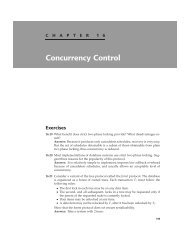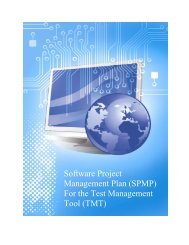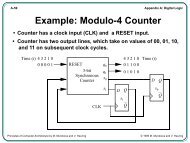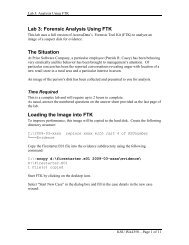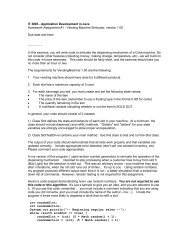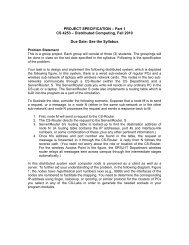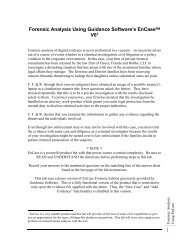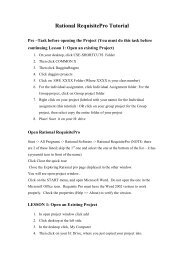You also want an ePaper? Increase the reach of your titles
YUMPU automatically turns print PDFs into web optimized ePapers that Google loves.
23.2.1.11 View Page<br />
DRAFT, February 18, 2003, Page 111<br />
These are global defaults for settings that appear on the CSD window view menu. The view menu<br />
settings are temporary.<br />
23.2.1.12 Sources Page (Global and Project Settings Only)<br />
Allows the search path for jGRASP to be specified. This path will be used for click-to-error in the jGRASP<br />
message windows as well as for finding classes shown in the call stack of the integrated debugger for<br />
Java. These are used when the message or call stack reference contains a relative path name or a Java<br />
class name. They are searched in order. If this is not set, only the working directory for the command that<br />
produced the message will be searched. If this is set, and one of the paths is "working directory", the<br />
working directory will be searched at that point. In most cases you will need to include "working directory"<br />
as one of the paths, probably the first.<br />
Paths are entered one per line, and must be absolute.<br />
This can be used, for example, to get click-to-error to work for JDK classes in Java stack dumps, if you<br />
have the JDK sources. In that case, the root of the JDK source tree (the directory containing the java,<br />
javax, etc. directories) should be on one line, and "working directory" on another. If you have Java<br />
sources and classes in separate directories, or use a make file in one directory with sources in another,<br />
you should specify the source directory or directories and not "working directory".<br />
23.3 Compiler Environment Dialog<br />
This dialog allows a compiler environment to be created, edited, or viewed. These environments specify<br />
compile and run commands, working directories, and error formats.<br />
• Name Field - name of the environment. Not editable for system environments.<br />
• Copy Button - copy the environment to the clipboard.<br />
• Paste Button - paste the environment from the clipboard.<br />
• Export Button - save the environment to file.<br />
• Import Button - load the environment from file.<br />
• Commands Page<br />
• Parse Page<br />
• Macros Page<br />
• OK Button - save the environment and close the dialog.<br />
• Save Button - save the environment without closing the dialog.<br />
• Clear Button - clear all the settings.<br />
• Reset Button - reset the dialog to the current state of the environment.<br />
• Cancel Button - close the dialog without saving the environment.<br />
23.3.1 Commands Page<br />
This page specifies settings for Compile, Compile and Link, Check, Run, Debug, and (for Java) Run as<br />
Applet and Debug as Applet commands. For each command a working directory and error format can be<br />
specified. If a compile command is empty, that command will not appear on the "Compiler" menu of the





